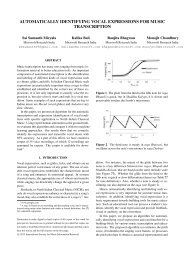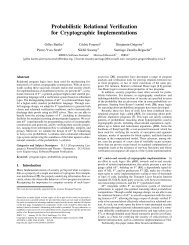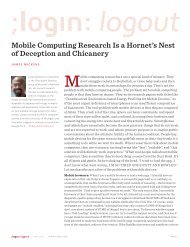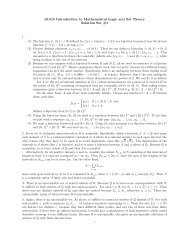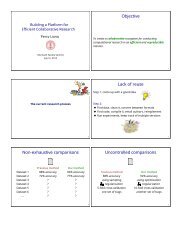Conversations in the Crowd - Microsoft Research
Conversations in the Crowd - Microsoft Research
Conversations in the Crowd - Microsoft Research
You also want an ePaper? Increase the reach of your titles
YUMPU automatically turns print PDFs into web optimized ePapers that Google loves.
<strong>Conversations</strong> <strong>in</strong> <strong>the</strong> <strong>Crowd</strong>:<br />
Collect<strong>in</strong>g Data for Task-Oriented Dialog Learn<strong>in</strong>g<br />
Walter S. Lasecki 1∗ , Ece Kamar 2 , Dan Bohus 2<br />
Computer Science Department 1<br />
University of Rochester<br />
wlasecki@cs.rochester.edu<br />
ASI Group 2<br />
<strong>Microsoft</strong> <strong>Research</strong><br />
{eckamar,dbohus}@microsoft.com<br />
Abstract<br />
A major challenge <strong>in</strong> develop<strong>in</strong>g dialog systems<br />
is obta<strong>in</strong><strong>in</strong>g realistic data to tra<strong>in</strong> <strong>the</strong> systems<br />
for specific doma<strong>in</strong>s. We study <strong>the</strong> opportunity<br />
for us<strong>in</strong>g crowdsourc<strong>in</strong>g methods to collect dialog<br />
datasets. Specifically, we <strong>in</strong>troduce ChatCollect, a<br />
system that allows researchers to collect conversations<br />
focused around def<strong>in</strong>able tasks from pairs of<br />
workers <strong>in</strong> <strong>the</strong> crowd. We demonstrate that varied<br />
and <strong>in</strong>-depth dialogs can be collected us<strong>in</strong>g<br />
this system, <strong>the</strong>n discuss ongo<strong>in</strong>g work on creat<strong>in</strong>g<br />
a crowd-powered system for pars<strong>in</strong>g semantic<br />
frames. We <strong>the</strong>n discuss research opportunities <strong>in</strong><br />
us<strong>in</strong>g this approach to tra<strong>in</strong> and improve automated<br />
dialog systems <strong>in</strong> <strong>the</strong> future.<br />
Introduction<br />
One of <strong>the</strong> primary bottlenecks <strong>in</strong> <strong>the</strong> development of<br />
task-oriented dialog systems, and <strong>in</strong> scal<strong>in</strong>g <strong>the</strong>m to<br />
multiple doma<strong>in</strong>s, is <strong>the</strong> availability of doma<strong>in</strong>-specific<br />
dialog data. Dialog systems harness multiple components,<br />
such as speech recognition, natural language understand<strong>in</strong>g,<br />
dialog management, natural language generation,<br />
and each of <strong>the</strong>se components requires and<br />
significantly benefits from <strong>the</strong> availability of doma<strong>in</strong>specific<br />
data resources and models. Examples <strong>in</strong>clude<br />
acoustic and language models, spoken language understand<strong>in</strong>g<br />
models, doma<strong>in</strong> ontologies, doma<strong>in</strong> <strong>in</strong>teraction<br />
plans, natural language generation templates, etc.<br />
Although many AI problems have benefitted from immensely<br />
grow<strong>in</strong>g data sources, end-to-end data acquisition<br />
for task-oriented dialog systems rema<strong>in</strong>s a challeng<strong>in</strong>g<br />
problem. Exist<strong>in</strong>g approaches for collect<strong>in</strong>g dialog<br />
data result <strong>in</strong> high development costs and are time<br />
consum<strong>in</strong>g for system developers. Unless external resources<br />
happen to already be available (which is not<br />
<strong>the</strong> case for most doma<strong>in</strong>s), <strong>in</strong>-doma<strong>in</strong> data collection<br />
requires hav<strong>in</strong>g a deployed system capable of susta<strong>in</strong><strong>in</strong>g<br />
a dialog with a user. This leads to a bootstrapp<strong>in</strong>g<br />
problem: given <strong>the</strong> lack of data to tra<strong>in</strong> <strong>the</strong> <strong>in</strong>itial systems,<br />
system developers carry <strong>the</strong> burden of develop-<br />
∗ The author did this work while at <strong>Microsoft</strong> <strong>Research</strong><br />
Copyright c○ 2013, Association for <strong>the</strong> Advancement of Artificial<br />
Intelligence (www.aaai.org). All rights reserved.<br />
Figure 1: User view of our task <strong>in</strong>terface. We recruit<br />
pairs of crowd workers (who assume ‘User’ and ‘Assistant’<br />
roles) to hold task-oriented conversations.<br />
<strong>in</strong>g grammars and language models ei<strong>the</strong>r manually or<br />
with Wizard-of-Oz studies. Collect<strong>in</strong>g dialog data with<br />
an early version of a deployed system has shortcom<strong>in</strong>gs:<br />
data collection quality may suffer from <strong>the</strong> <strong>in</strong>adequacies<br />
of <strong>the</strong> system itself, and users may bias <strong>the</strong>ir language<br />
to adjust for <strong>the</strong> deficiencies of <strong>the</strong> system <strong>in</strong> <strong>the</strong> pursuit<br />
of hav<strong>in</strong>g a successful dialog. As a result, <strong>the</strong> speed<br />
of data collection may be slower than desired. F<strong>in</strong>ally,<br />
this costly development process must be repeated all<br />
over aga<strong>in</strong> for each new doma<strong>in</strong> or system, or even when<br />
new functionality is added.<br />
We <strong>in</strong>vestigate <strong>the</strong> use of crowdsourc<strong>in</strong>g for collect<strong>in</strong>g<br />
task-oriented text-based dialog data. We present<br />
ongo<strong>in</strong>g work on ChatCollect, a system that coord<strong>in</strong>ates<br />
workers on a crowdsourc<strong>in</strong>g platform, by pair<strong>in</strong>g<br />
<strong>the</strong>m up <strong>in</strong> real-time, assign<strong>in</strong>g <strong>the</strong>m dialog roles,<br />
ask<strong>in</strong>g <strong>the</strong>m to accomplish a given task toge<strong>the</strong>r, and<br />
record<strong>in</strong>g <strong>the</strong>ir <strong>in</strong>teractions. The system requires m<strong>in</strong>imal<br />
<strong>in</strong>put from system developers; it only asks for a<br />
description of <strong>the</strong> task to be given to workers.<br />
We discuss results and lessons learned from an <strong>in</strong>itial<br />
experiment, and present statistics that help characterize<br />
<strong>the</strong> trends we observed <strong>in</strong> <strong>the</strong>se conversations.
While fur<strong>the</strong>r <strong>in</strong>vestigation is needed, our <strong>in</strong>itial results<br />
suggest that this is a feasible approach for collect<strong>in</strong>g<br />
task-oriented dialog data. We discuss future steps to<br />
improve <strong>the</strong> efficiency of data collection with <strong>the</strong> system.<br />
We conclude with a discussion of ongo<strong>in</strong>g work<br />
on provid<strong>in</strong>g tra<strong>in</strong><strong>in</strong>g data for spoken language understand<strong>in</strong>g<br />
models by hav<strong>in</strong>g <strong>the</strong> crowd collectively parse<br />
logs from <strong>the</strong> conversation <strong>in</strong>to <strong>the</strong>ir correspond<strong>in</strong>g semantic<br />
frames. Our work suggests a possible future <strong>in</strong><br />
which <strong>the</strong> crowd can be used to <strong>in</strong>creas<strong>in</strong>gly automate<br />
<strong>the</strong> process of build<strong>in</strong>g dialog systems <strong>in</strong> new doma<strong>in</strong>s,<br />
on-demand, with m<strong>in</strong>imal effort from developers.<br />
Background<br />
Our approach draws from rich prior work <strong>in</strong> both conversational<br />
dialog systems, and crowdsourc<strong>in</strong>g.<br />
Conversational Dialog Systems<br />
Our ChatCollect system is designed to alleviate <strong>the</strong><br />
development efforts for dialog systems. The manual<br />
author<strong>in</strong>g of <strong>the</strong>se systems has been recognized as a<br />
time consum<strong>in</strong>g effort that requires doma<strong>in</strong> expertise<br />
(Ward and Pellom 1999). This challeng<strong>in</strong>g and timeconsum<strong>in</strong>g<br />
process has been used <strong>in</strong> <strong>the</strong> development<br />
of many dialog systems (e.g., (Gandhe et al. 2009;<br />
Aleven et al. 2006; Allen et al. 1996)). Alternative approaches<br />
have focused on learn<strong>in</strong>g from transcribed<br />
human-human dialogs (Gor<strong>in</strong>, Riccardi, and Wright<br />
1997) or dialogs collected through Wizard-of-Oz studies<br />
(Lathrop 2004). However, exist<strong>in</strong>g human-human corpora<br />
apply to limited doma<strong>in</strong>s, and collect<strong>in</strong>g data for<br />
new doma<strong>in</strong>s with <strong>the</strong> exist<strong>in</strong>g techniques is difficult<br />
and expensive. Moreover, <strong>the</strong>y do not scale well – an<br />
important aspect given <strong>the</strong> amount of data needed to<br />
tra<strong>in</strong> accurate models for dialog systems. The system<br />
proposed <strong>in</strong> this paper holds promise for obta<strong>in</strong><strong>in</strong>g natural<br />
dialog data for various doma<strong>in</strong>s with little to no<br />
<strong>in</strong>volvement from system designers. The approach may<br />
enable automated tra<strong>in</strong><strong>in</strong>g of future dialog systems and<br />
speed up <strong>the</strong> real-world deployment of such systems.<br />
<strong>Crowd</strong>sourc<strong>in</strong>g<br />
<strong>Crowd</strong>sourc<strong>in</strong>g has ga<strong>in</strong>ed immense popularity <strong>in</strong> recent<br />
years as a means to provide programmatic, easy,<br />
and scalable access to human <strong>in</strong>telligence. <strong>Crowd</strong>sourc<strong>in</strong>g<br />
has been applied to a large variety of tasks rang<strong>in</strong>g<br />
from search relevance (Chen et al. 2013) to image description<br />
(Bigham et al. 2010). Recently, <strong>the</strong>re has been<br />
grow<strong>in</strong>g <strong>in</strong>terest <strong>in</strong> apply<strong>in</strong>g crowdsourc<strong>in</strong>g to language<br />
problems. <strong>Crowd</strong>sourc<strong>in</strong>g tasks have been designed for<br />
speech transcription (Lasecki et al. 2012), speech acquisition<br />
(Lane et al. 2010), translation (Zaidan and<br />
Callison-Burch 2011) and paraphrase generation (Burrows,<br />
Potthast, and Ste<strong>in</strong> 2013). Some prior work has<br />
particularly focused on crowdsourc<strong>in</strong>g methods for <strong>the</strong><br />
development of dialog systems. Wang et. al. studied<br />
methods for elicit<strong>in</strong>g natural language for a given semantic<br />
form (Wang et al. 2012). The Asgard system<br />
uses crowdsourc<strong>in</strong>g for free-form language generation<br />
and for <strong>the</strong> semantic label<strong>in</strong>g of segments of <strong>the</strong> collected<br />
language (Liu et al. 2013). Bessho et. al. (Bessho,<br />
Harada, and Kuniyoshi 2012) developed a dialog system<br />
that requests efforts from a real-time crowd to make<br />
progress <strong>in</strong> a dialog when automated approaches fail.<br />
Cont<strong>in</strong>uous real-time crowdsourc<strong>in</strong>g was <strong>in</strong>troduced<br />
by Lasecki et. al (Lasecki et al. 2011) <strong>in</strong> order to create<br />
crowd-powered systems capable of <strong>in</strong>teract<strong>in</strong>g with<br />
<strong>the</strong>ir users and <strong>the</strong>ir environment. This approach was<br />
applied to conversational <strong>in</strong>teraction <strong>in</strong> Chorus (Lasecki<br />
et al. 2013b; 2013a), a conversational question answer<strong>in</strong>g<br />
system. Both of <strong>the</strong>se systems are able to quickly get<br />
<strong>in</strong>put from crowd workers by pre-recruit<strong>in</strong>g (Bigham et<br />
al. 2010; Bernste<strong>in</strong> et al. 2011). ChatCollect differs from<br />
<strong>the</strong>se systems by recruit<strong>in</strong>g all sides of <strong>the</strong> dialog from<br />
<strong>the</strong> crowd for automated dialog generation.<br />
ChatCollect System<br />
The ChatCollect system is designed to collect realistic<br />
task-oriented dialog data from crowd workers. The<br />
only <strong>in</strong>puts of <strong>the</strong> system developer to <strong>the</strong> ChatCollect<br />
system are <strong>the</strong> different tasks <strong>the</strong> developer wants to<br />
collect data about. For example, a developer may tell<br />
ChatCollect to collect data about flight reservations,<br />
plann<strong>in</strong>g a night out or decid<strong>in</strong>g what car to buy.<br />
The ChatCollect system hires a pair of workers from a<br />
crowdsourc<strong>in</strong>g marketplace <strong>in</strong> real-time and l<strong>in</strong>ks <strong>the</strong>m<br />
to an <strong>in</strong>stant-messenger style chat w<strong>in</strong>dow to have a<br />
conversation about <strong>the</strong> given task, and assigns a role to<br />
each worker. The first worker routed to <strong>the</strong> chat w<strong>in</strong>dow<br />
is assigned <strong>the</strong> role of <strong>the</strong> “Assistant” and is <strong>in</strong>structed<br />
to help someone with <strong>the</strong> task at hand, such as f<strong>in</strong>d<strong>in</strong>g<br />
a flight. The second worker is assigned <strong>the</strong> role of<br />
<strong>the</strong> “User” and is given a task type to complete with<br />
<strong>the</strong> help of <strong>the</strong> Assistant (e.g., f<strong>in</strong>d flight). In order to<br />
add realistic depth to <strong>the</strong> conversations held by workers<br />
play<strong>in</strong>g a part, <strong>the</strong> system does not prime <strong>the</strong> User<br />
with <strong>the</strong> details of <strong>the</strong> task she needs to complete, but<br />
<strong>in</strong>stead it asks <strong>the</strong> User to imag<strong>in</strong>e such a sett<strong>in</strong>g. Both<br />
workers are <strong>in</strong>structed not to share any personally identifiable<br />
<strong>in</strong>formation about <strong>the</strong>mselves.<br />
S<strong>in</strong>ce <strong>the</strong> Assistant is hired first and routed to <strong>the</strong><br />
chat <strong>in</strong>terface, <strong>the</strong> User f<strong>in</strong>ds <strong>the</strong> Assistant wait<strong>in</strong>g<br />
when she is routed to <strong>the</strong> chat <strong>in</strong>terface. The User is<br />
<strong>in</strong>structed to start <strong>the</strong> dialog when she is at <strong>the</strong> chat<br />
<strong>in</strong>terface by tell<strong>in</strong>g <strong>the</strong> Assistant about <strong>the</strong> task. The<br />
User and Assistant both share <strong>in</strong>formation about <strong>the</strong><br />
task, discuss possible solutions, and revise <strong>the</strong> task.<br />
Workers are asked to complete <strong>the</strong> task as well as<br />
possible (ra<strong>the</strong>r than meet <strong>the</strong> m<strong>in</strong>imum requirements,<br />
or just accept any response). Once <strong>the</strong> User deems that<br />
<strong>the</strong> task is complete, she can signal <strong>the</strong> end of <strong>the</strong> <strong>in</strong>teraction<br />
by click<strong>in</strong>g “done”, which forwards her and<br />
<strong>the</strong> Assistant worker to a survey page ask<strong>in</strong>g <strong>the</strong>m each<br />
about <strong>the</strong> quality of <strong>the</strong> <strong>in</strong>teraction <strong>the</strong>y had. The survey<br />
also asks <strong>the</strong> Assistant workers about <strong>the</strong> resources<br />
(e.g., websites) <strong>the</strong>y used to complete <strong>the</strong> given task.
We designed a payment scheme for <strong>the</strong> ChatCollect<br />
system that rewards workers based on <strong>the</strong> time<br />
<strong>the</strong>y spend on <strong>the</strong> task as well as <strong>the</strong> quality of dialog<br />
<strong>the</strong>y had (assessed by evaluators, or <strong>the</strong>ir conversational<br />
partner). Workers are paid a fixed amount per m<strong>in</strong>ute<br />
for wait<strong>in</strong>g for <strong>the</strong>ir partner to arrive and for <strong>the</strong> dialog<br />
to start. We <strong>the</strong>n review <strong>the</strong> dialogs after completion<br />
and assign a bonus amount for each dialog to reward<br />
<strong>the</strong> dialogs that successfully complete <strong>the</strong>ir task.<br />
Experiments<br />
We evaluated <strong>the</strong> ChatCollect system on <strong>the</strong> Universal<br />
Human Relevance System (UHRS) crowdsourc<strong>in</strong>g<br />
marketplace, <strong>Microsoft</strong>’s <strong>in</strong>ternal crowdsourc<strong>in</strong>g platform.<br />
Similar to o<strong>the</strong>r platforms, UHRS connects a large<br />
worker pool from different regions <strong>in</strong> <strong>the</strong> world with requesters<br />
seek<strong>in</strong>g human <strong>in</strong>put. Previous work on this<br />
platform shows that workers provide high quality work<br />
with low latency (Wang et al. 2012). In our experiments,<br />
we used American English speak<strong>in</strong>g workers.<br />
In order to see what <strong>the</strong>se conversations will look like,<br />
we collected an <strong>in</strong>itial dataset that could be manually<br />
analyzed. We collected this data <strong>in</strong> 3 sessions, result<strong>in</strong>g<br />
<strong>in</strong> 16 completed conversations focus<strong>in</strong>g on two tasks:<br />
f<strong>in</strong>d<strong>in</strong>g a flight, and f<strong>in</strong>d<strong>in</strong>g a hotel. The details for <strong>the</strong>se<br />
tasks (e.g., city) were not told to workers, but <strong>in</strong>stead<br />
chosen by <strong>the</strong> worker as part of <strong>the</strong>ir role-play<strong>in</strong>g.<br />
Success rate Our 16 successful conversations were<br />
drawn from 38 started sessions. While this is only a<br />
42.1% completion rate for paired workers, our manual<br />
evaluation shows that every one of <strong>the</strong> conversations<br />
that lasted more than one round were marked as complete<br />
by <strong>the</strong> workers and were evaluated by us as successful.<br />
This means that filter<strong>in</strong>g out bad sessions is<br />
easy, help<strong>in</strong>g to keep <strong>the</strong> cost of data collection low.<br />
All of <strong>the</strong> completed conversations conta<strong>in</strong>ed valid responses<br />
to <strong>the</strong> questions asked.<br />
This analysis suggests that once two workers are<br />
paired for <strong>the</strong> task and start a conversation, <strong>the</strong>y complete<br />
a successful dialog. The unsuccessful conversations<br />
resulted from workers not be<strong>in</strong>g successfully paired <strong>in</strong><br />
real-time. For example, <strong>in</strong> a number of <strong>the</strong> <strong>in</strong>stances,<br />
<strong>the</strong> assistant worker left <strong>the</strong> system before a user worker<br />
could be assigned to <strong>the</strong> task to start a dialog. The average<br />
wait time for a worker <strong>in</strong> a successful conversation<br />
was 4:41 m<strong>in</strong>utes (median 2:16 m<strong>in</strong>utes), while <strong>the</strong> average<br />
wait time for an unsuccessful one was 34:35 m<strong>in</strong>utes<br />
(median 6:16 m<strong>in</strong>utes).<br />
Length of <strong>Conversations</strong> There were a total of 343<br />
turns <strong>in</strong> <strong>the</strong> conversations we collected, with an average<br />
of 21.4 (median 19) turns conta<strong>in</strong><strong>in</strong>g 268.5 (median<br />
243) words per conversation. The standard deviation<br />
was 13.7 turns and 197.5 words, show<strong>in</strong>g <strong>the</strong> conversations<br />
varied significantly <strong>in</strong> length. In fact, <strong>the</strong> m<strong>in</strong>imum<br />
number of turns was 6, while <strong>the</strong> maximum was<br />
58. The m<strong>in</strong>imum number of words was 75 (from a conversation<br />
with 8 turns) and <strong>the</strong> maximum was 748. As<br />
may be expected, number of turns was a strong predictor<br />
of amount of <strong>in</strong>teraction (number of words).<br />
Variation Between <strong>Conversations</strong> In <strong>the</strong> 16 conversations<br />
between pairs of workers, 19 unique workers<br />
participated. Despite <strong>the</strong> fact that some workers repeated<br />
(which we explicitly allowed), none of <strong>the</strong> conversations<br />
repeated which city or pair of cities were <strong>in</strong>volved<br />
<strong>in</strong> <strong>the</strong> travel plans.<br />
Worker Feedback From <strong>the</strong> 16 conversations, we<br />
collected 25 survey responses: 13 from Users and 12<br />
from Assistants. Of <strong>the</strong> Users, 11 (84.6%) replied that<br />
<strong>the</strong>y were “very satisfied” with <strong>the</strong> responses from<br />
<strong>the</strong> assistant, one said <strong>the</strong>y were “somewhat satisfied”,<br />
and one said <strong>the</strong>y were “very dissatisfied”, though this<br />
worker claimed to be happy with <strong>the</strong> response <strong>in</strong> <strong>the</strong><br />
chat itself.<br />
11 of 13 Users said <strong>the</strong> <strong>in</strong>terface made <strong>the</strong>ir task “very<br />
easy” to complete, while two said it was “somewhat<br />
easy”. 8 out of 12 of <strong>the</strong> Assistants thought <strong>the</strong> task<br />
was “very easy” to complete, 3 found it “somewhat<br />
easy”, and one was neutral. Six of <strong>the</strong>se workers reported<br />
that <strong>the</strong> hardest part of <strong>the</strong> task was f<strong>in</strong>d<strong>in</strong>g <strong>the</strong><br />
right questions to ask to determ<strong>in</strong>e <strong>the</strong> user’s preferences.<br />
To complete <strong>the</strong>ir task, Assistants used typical<br />
web tools such as Google, Kayak, or Expedia. Overall,<br />
5 workers specifically mentioned enjoy<strong>in</strong>g <strong>the</strong> task<br />
<strong>in</strong> <strong>the</strong> free-response section of <strong>the</strong> survey, support<strong>in</strong>g<br />
prior work us<strong>in</strong>g Mechanical Turk that also found a<br />
large percentage of workers enjoyed a conversational<br />
task (Lasecki et al. 2013b).<br />
<strong>Crowd</strong> Pars<strong>in</strong>g of Semantic Frames<br />
One potential avenue for us<strong>in</strong>g <strong>the</strong> data collected <strong>in</strong><br />
this manner is to construct corpora for develop<strong>in</strong>g <strong>the</strong><br />
doma<strong>in</strong>-specific spoken language understand<strong>in</strong>g component<br />
of a dialog system. In slot-fill<strong>in</strong>g type doma<strong>in</strong>s, this<br />
amounts to identify<strong>in</strong>g <strong>the</strong> doma<strong>in</strong> ontology, i.e. <strong>the</strong> set<br />
of doma<strong>in</strong>-specific frames, <strong>the</strong> correspond<strong>in</strong>g slots and<br />
values, and develop<strong>in</strong>g a labeled corpus that captures<br />
<strong>the</strong> semantic parses for each lexical turn <strong>in</strong> <strong>the</strong> dialog.<br />
We address this problem by develop<strong>in</strong>g <strong>Crowd</strong>Parse,<br />
a system that uses <strong>the</strong> crowd to parse dialogs <strong>in</strong>to semantic<br />
frames as <strong>the</strong> conversation progresses. As a result<br />
of this task, we can generate dialog data accompanied<br />
with semantic labels that can be directly used<br />
<strong>in</strong> tra<strong>in</strong><strong>in</strong>g spoken language understand<strong>in</strong>g components<br />
(Liu et al. 2013). <strong>Crowd</strong>Parse asks workers to evaluate<br />
<strong>the</strong> <strong>in</strong>formation provided <strong>in</strong> a task-oriented dialog and<br />
extract frames (tasks), fields (types of <strong>in</strong>formation), and<br />
values (<strong>in</strong>formation provided) for both sides of <strong>the</strong> conversation.<br />
As <strong>the</strong> conversation progresses, workers add<br />
<strong>in</strong>formation, build<strong>in</strong>g on <strong>the</strong> prior <strong>in</strong>formation captured<br />
by ei<strong>the</strong>r <strong>the</strong>ir previous step or prior workers.<br />
When workers take <strong>the</strong> <strong>Crowd</strong>Parse task, <strong>the</strong>y are<br />
routed to a po<strong>in</strong>t <strong>in</strong> a conversation. They <strong>the</strong>n update<br />
<strong>the</strong> frame <strong>the</strong>y are presented with, and cont<strong>in</strong>ue to a<br />
new task until <strong>the</strong>y choose to stop.
Discussion and Future Work<br />
Our <strong>in</strong>itial results suggest that ChatCollect can provide<br />
an effective tool for collect<strong>in</strong>g task-oriented dialog<br />
data. We limited <strong>the</strong> size of <strong>the</strong> data collected for this<br />
exploratory work to 16 <strong>in</strong> order to more easily review<br />
each conversation manually, but ChatCollect can be run<br />
cont<strong>in</strong>uously to collect larger datasets. In future work,<br />
it will be <strong>in</strong>terest<strong>in</strong>g to explore how <strong>the</strong> dialog data<br />
collected with our system compares to prior datasets<br />
generated by br<strong>in</strong>g<strong>in</strong>g participants <strong>in</strong>to a lab sett<strong>in</strong>g,<br />
or collected through a deployed system.<br />
While <strong>the</strong> completed conversations were all successful,<br />
fewer than half of <strong>the</strong> chat sessions that workers<br />
were routed to were completed. The ma<strong>in</strong> reason for this<br />
was that sometimes a large delay would occur between<br />
<strong>the</strong> arrivals of <strong>the</strong> two workers. Accord<strong>in</strong>gly, none of <strong>the</strong><br />
<strong>in</strong>complete conversations had more than one round of<br />
dialog (each party spoke at most once when <strong>the</strong>y arrived,<br />
but <strong>the</strong> first left before <strong>the</strong> second arrived). A<br />
quick way to address this issue is follow<strong>in</strong>g marketplace<br />
specific strategies to attract workers to our tasks more<br />
quickly, such as repost<strong>in</strong>g tasks to <strong>in</strong>crease task visibility.<br />
As a more permanent fix, future versions of Chat-<br />
Collect will detect when one party disconnects, and<br />
route <strong>the</strong> o<strong>the</strong>r to an active task (with appropriate compensation<br />
for any work done so far). This also helps <strong>in</strong><br />
<strong>the</strong> case when a conversation is partially complete, and<br />
one worker leaves, as was observed <strong>in</strong> prelim<strong>in</strong>ary test<strong>in</strong>g.<br />
Also, pre-recruit<strong>in</strong>g approaches used <strong>in</strong> prior work<br />
can help ensure worker availability (Bigham et al. 2010;<br />
Bernste<strong>in</strong> et al. 2011).<br />
Our ultimate goal is to enable <strong>the</strong> automatic tra<strong>in</strong><strong>in</strong>g<br />
and scal<strong>in</strong>g of dialog systems to new doma<strong>in</strong>s. Future<br />
versions of <strong>the</strong> system will <strong>in</strong>vestigate collect<strong>in</strong>g speech<br />
from workers with microphones <strong>in</strong> order to tra<strong>in</strong> spoken<br />
language understand<strong>in</strong>g components. We believe such<br />
a pipel<strong>in</strong>e can reduce <strong>the</strong> cost of develop<strong>in</strong>g dialog systems<br />
that are able to easily generalize to new doma<strong>in</strong>s.<br />
Conclusion<br />
<strong>Crowd</strong>sourc<strong>in</strong>g methods such as <strong>the</strong> ones presented here<br />
offer new opportunities for develop<strong>in</strong>g dialog systems<br />
that can cont<strong>in</strong>uously learn on demand with low cost.<br />
In this paper, we <strong>in</strong>troduced ChatCollect, a system for<br />
collect<strong>in</strong>g task-oriented dialog data us<strong>in</strong>g pairs of crowd<br />
workers. We presented some results from an <strong>in</strong>itial set of<br />
16 conversations conta<strong>in</strong><strong>in</strong>g a total of 4296 turns which<br />
we analyzed manually, f<strong>in</strong>d<strong>in</strong>g that <strong>the</strong>se conversations<br />
are appropriately varied and on-topic. We also discussed<br />
ongo<strong>in</strong>g work on <strong>Crowd</strong>Parse, a system that uses <strong>the</strong><br />
crowd to parse semantic frames from dialogs. We believe<br />
this work takes first steps towards a future <strong>in</strong> which<br />
dialog systems can be easily tra<strong>in</strong>ed <strong>in</strong> new doma<strong>in</strong>s by<br />
us<strong>in</strong>g crowd-generated datasets.<br />
Acknowledgements<br />
The authors would like to thank Eric Horvitz for many<br />
<strong>in</strong>sightful discussions about this work.<br />
References<br />
Aleven, V.; Sewall, J.; McLaren, B. M.; and Koed<strong>in</strong>ger,<br />
K. R. 2006. Rapid author<strong>in</strong>g of <strong>in</strong>telligent tutors for realworld<br />
and experimental use. In ICALT 2006, 847–851.<br />
Allen, J. F.; Miller, B. W.; R<strong>in</strong>gger, E. K.; and Sikorski,<br />
T. 1996. A robust system for natural spoken dialogue. In<br />
Proceed<strong>in</strong>gs of ACL 1996, 62–70.<br />
Bernste<strong>in</strong>, M. S.; Brandt, J. R.; Miller, R. C.; and Karger,<br />
D. R. 2011. <strong>Crowd</strong>s <strong>in</strong> two seconds: Enabl<strong>in</strong>g realtime<br />
crowd-powered <strong>in</strong>terfaces. In Proc. of UIST 2011, 33–42.<br />
Bessho, F.; Harada, T.; and Kuniyoshi, Y. 2012. Dialog<br />
system us<strong>in</strong>g real-time crowdsourc<strong>in</strong>g and twitter large-scale<br />
corpus. In Proceed<strong>in</strong>gs of SIGDIAL 2012, 227–231.<br />
Bigham, J. P.; Jayant, C.; Ji, H.; Little, G.; Miller, A.;<br />
Miller, R. C.; Miller, R.; Tatarowicz, A.; White, B.; White,<br />
S.; and Yeh, T. 2010. Vizwiz: nearly real-time answers to<br />
visual questions. In Proceed<strong>in</strong>gs of UIST 2010, 333–342.<br />
Burrows, S.; Potthast, M.; and Ste<strong>in</strong>, B. 2013. Paraphrase<br />
acquisition via crowdsourc<strong>in</strong>g and mach<strong>in</strong>e learn<strong>in</strong>g. ACM<br />
Trans. Intell. Syst. Technol. 4(3):43:1–43:21.<br />
Chen, X.; Bennett, P. N.; Coll<strong>in</strong>s-Thompson, K.; and<br />
Horvitz, E. 2013. Pairwise rank<strong>in</strong>g aggregation <strong>in</strong> a crowdsourced<br />
sett<strong>in</strong>g. In Proceed<strong>in</strong>gs of WSDM 2013, 193–202.<br />
Gandhe, S.; DeVault, D.; Roque, A.; Mart<strong>in</strong>ovski, B.; Artste<strong>in</strong>,<br />
R.; A. Leuski, J. G.; and Traum, D. 2009. From<br />
doma<strong>in</strong> specification to virtual humans: An <strong>in</strong>tegrated approach<br />
to author<strong>in</strong>g tactical question<strong>in</strong>g characters. In Proceed<strong>in</strong>gs<br />
of Interspeech 2008.<br />
Gor<strong>in</strong>, A. L.; Riccardi, G.; and Wright, J. H. 1997. How<br />
may i help you? Speech Commun. 23(1-2):113–127.<br />
Lane, I.; Waibel, A.; Eck, M.; and Rottmann, K. 2010.<br />
Tools for collect<strong>in</strong>g speech corpora via mechanical-turk. In<br />
Proceed<strong>in</strong>gs of <strong>the</strong> NAACL HLT 2010 Workshop on Creat<strong>in</strong>g<br />
Speech and Language Data with Amazon’s Mechanical Turk,<br />
CSLDAMT ’10, 184–187.<br />
Lasecki, W.; Murray, K.; White, S.; Miller, R. C.; and<br />
Bigham, J. P. 2011. Real-time crowd control of exist<strong>in</strong>g<br />
<strong>in</strong>terfaces. In Proceed<strong>in</strong>gs of UIST 2011, 23–32.<br />
Lasecki, W.; Miller, C.; Sadilek, A.; AbuMoussa, A.; and<br />
Bigham, J. 2012. Real-time caption<strong>in</strong>g by groups of nonexperts.<br />
In Proceed<strong>in</strong>gs of UIST 2012.<br />
Lasecki, W. S.; Thiha, P.; Zhong, Y.; Brady, E.; and Bigham,<br />
J. P. 2013a. Answer<strong>in</strong>g visual questions with conversational<br />
crowd assistants. In Proc. of ASSETS 2013, To Appear.<br />
Lasecki, W.; Wesley, R.; Nichols, J.; Kulkarni, A.; Allen, J.;<br />
and Bigham, J. 2013b. Chorus: A crowd-powered conversational<br />
assistant. In Proceed<strong>in</strong>gs of UIST 2013, To Appear.<br />
Lathrop, B. e. a. 2004. A wizard of oz framework for collect<strong>in</strong>g<br />
spoken human-computer dialogs: An experiment procedure<br />
for <strong>the</strong> design and test<strong>in</strong>g of natural language <strong>in</strong>-vehicle<br />
technology systems. In Proceed<strong>in</strong>gs of ITS 2004.<br />
Liu, J.; Pasupat, P.; Cyphers, S.; and Glass, J. 2013. Asgard:<br />
A portable architecture for multil<strong>in</strong>gual dialogue systems. In<br />
Proceed<strong>in</strong>gs of ICASSP 2013.<br />
Wang, W. Y.; Bohus, D.; Kamar, E.; and Horvitz, E. 2012.<br />
<strong>Crowd</strong>sourc<strong>in</strong>g <strong>the</strong> acquisition of natural language corpora:<br />
Methods and observations. In SLT 2012. IEEE.<br />
Ward, W., and Pellom, B. 1999. The cu communicator<br />
system. In Proceed<strong>in</strong>gs of IEEE ASRU.<br />
Zaidan, O. F., and Callison-Burch, C. 2011. <strong>Crowd</strong>sourc<strong>in</strong>g<br />
translation: professional quality from non-professionals. In<br />
Proceed<strong>in</strong>gs of HLT 2011, 1220–1229.



